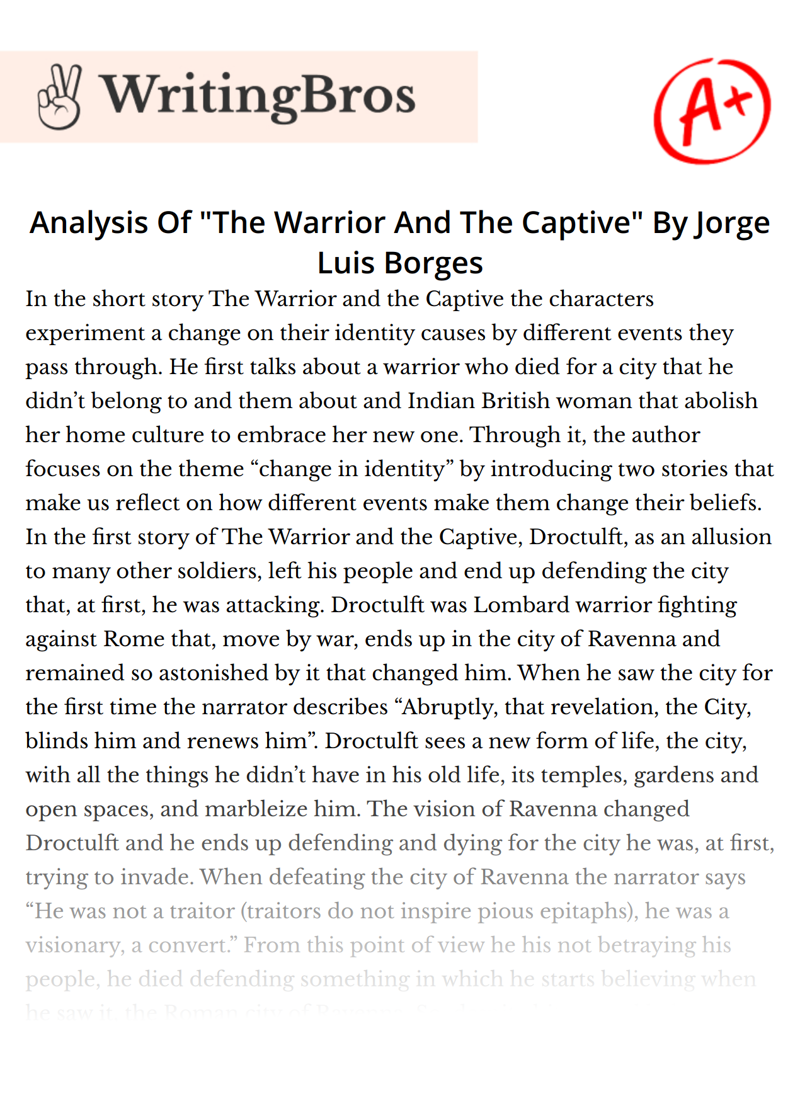Analysis Of "The Warrior And The Captive" By Jorge Luis Borges

In the short story The Warrior and the Captive the characters experiment a change on their identity causes by different events they pass through. He first talks about a warrior who died for a city that he didn’t belong to and them about and Indian British woman that abolish her home culture to embrace her new one. Through it, the author focuses on the theme “change in identity” by introducing two stories that make us reflect on how different events make them change their beliefs. In the first story of The Warrior and the Captive, Droctulft, as an allusion to many other soldiers, left his people and end up defending the city that, at first, he was attacking.
Droctulft was Lombard warrior fighting against Rome that, move by war, ends up in the city of Ravenna and remained so astonished by it that changed him. When he saw the city for the first time the narrator describes “Abruptly, that revelation, the City, blinds him and renews him”. Droctulft sees a new form of life, the city, with all the things he didn’t have in his old life, its temples, gardens and open spaces, and marbleize him. The vision of Ravenna changed Droctulft and he ends up defending and dying for the city he was, at first, trying to invade. When defeating the city of Ravenna the narrator says “He was not a traitor (traitors do not inspire pious epitaphs), he was a visionary, a convert.” From this point of view he his not betraying his people, he died defending something in which he starts believing when he saw it, the Roman city of Ravenna.
So, despite hit natural belonging to the Lombard society, Droctulft decided to join and died for a new city, changed everything he had believed in for Ravenna, just because that is what he felt it was the right thing.In the second story, the author focused on an English woman that was forced to move to South America and how she adapted and revel into the new culture through the perspective of another English woman, proud of her belonging. The Indian was an English woman that, despite being captured by the Indians and forced to do brutal things, she is offered to escape her graceless life and refused it. When the English woman finds the Indian in the forest drinking sheep blood the narrator claims “I don’t know whether she did this because she could no longer act differently or as a challenge and sign”. This statement shows how the Indian culture had changed the woman until the point she was betraying human principles and perpetrating this horrible act despite the fact she used to be part of the refined British culture.
In conclusion, the short story "The Warrior and the Captive" explores the theme of "change in identity" through the experiences of two very different characters. The first character, Droctulft, is a Lombard warrior who dies defending the Roman city of Ravenna, a city he was originally attacking. The vision of the city changed everything he believed in and he became a convert. The second character, the Indian British woman, was forced to leave her home culture and embrace a new one in South America. The narrator shows how her adaptation to the new culture changed her to the point of betraying human principles. Both stories show how events and experiences can cause a person to change their beliefs and identity. The characters of Droctulft and the Indian British woman represent a metaphor for the process of adapting and changing, and this story encourages readers to reflect on their own experiences and how they have shaped their identities. Ultimately, "The Warrior and the Captive" is a powerful reminder that change is a natural part of life and that the ability to adapt and embrace new experiences is an important part of personal growth.
References
- Borges, J. L. (1962). El Aleph. Buenos Aires: Emecé.
- Shaw, D. W. (1976). Jorge Luis Borges: A study of the short fiction. Twayne Publishers.
- Bacigalupo, G. (1984). Jorge Luis Borges: A literary biography. St. Martin's Press.
- Kosinski, D. P. (1982). The matrix of identity in Borges. The Review of Contemporary Fiction, 2(2), 36-43.
- Fuentes, C. (1999). Borges and the eternal Orangutans. Granta Books.
Cite this Essay
To export a reference to this article please select a referencing style below

